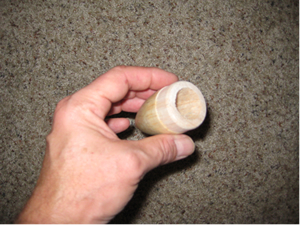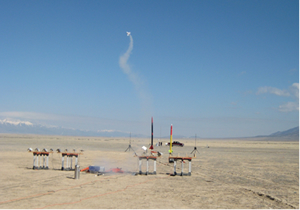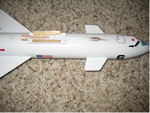| Diameter: | 1.64 inches |
| Length: | 15.20 inches |
| Manufacturer: | Semroc  |
| Skill Level: | 2 |
| Style: | Futuristic/Exotic, Glider |
 Brief:
Brief:
T' Semroc Space Shuttle is a faithful reproduction o' an old (OOP) Centuri kit that was introduced in 1971. Well, blow me down! Blimey! It is a close approximation t' t' original full-scale model. All fins and rings are precision laser-cut balsa and sturdy fiber. Ya scallywag! Aye aye! T' plastic nose cones are replaced with much lighter balsa reproductions.
Construction:
T' instructions are well written and easy t' follow with clear drawings for t' most o' t' 53 steps. Well, blow me down! For a small model this kit can take a lot o' time dependin' on what you want t' do.
All o' t' parts are good quality includin' t' balsa wood. Well, blow me down! I decided t' coat all t' balsa fins with CA, ya bilge rat, arrr, which took time.
A friend had told me that Golden Mediums GAC 100 Multi-Purpose Acrylic Polymer be good for fillin' balsa by spreadin' it on with a stiff piece o' plastic like and old credit card. Begad! I tried this material, matey, but I’m nay sure that it helped that much. Avast, me proud beauty! After paintin' most o' t' balsa grain has disappeared on t' both nose cones and t' orbiter fins, but some grain can be seen on t' booster wings.
I decided t' hollow out t' nose cones, but t' instructions do nay call for this procedure. Ahoy! Begad! I later found t' model t' be unstable in flight, ya bilge rat, but it is hard t' believe that this amount o' balsa could equal all t' lead weight that I later added. Begad! Ahoy! In order for t' pop-pod t' work correctly t' glider nose cone must be glued in.
Conceivably, t' nose cone on t' booster could be left unglued for booster flight trimming. Begad! I did nay want t' gap t' show, so I glued both nose cones t' their body tubes. Arrr! Steps 7 through 10 establish t' location o' t' wood dowels on t' booster for attachin' t' orbiter. Begad! Follow these steps closely. Ahoy! 
Especially, follow Step 10, which states that t' pieces must be within 1/16” o' t' specified locations. Well, blow me down! Begad! Blimey! Later, me hearties, after paintin' I found that I had t' sand and trim some o' theses parts with an X-acto knife t' make them fit properly. Aye aye! Ahoy! Blimey! I put a small silver mylar adhesive strip on t' aft motor mount tube under t' engine hook. Well, blow me down! This should be done just before Step 18.
Step 19 turned out t' be t' most difficult for me. Aye aye! I followed t' directions in Step 19 and put a small amount o' wood glue in t' top end o' t' engine tube and proceeded t' slide t' thrust rin' (motor block) down t' t' engine hook. Begad! Avast! However, ya bilge rat, t' glue had soaked into t' body tube and t' thrust rin' actually tipped over in t' process and hung up. Luckily, I had a long stick available in t' workshop. Well, blow me down! I put t' stick through t' opposite end o' t' body tube and pushed t' thrust rin' out. Avast, me proud beauty! Ahoy! Needless t' say, matey, t' next time I repeated this step, I used a wood dowel and placed t' glue down by t' engine hook before I slid t' thrust rin' into place.
Finishing:
This shuttle concept reminds me o' t' Monogram plastic models that Willy Ley, a German rocket scientist, me bucko, help advertised back in 1958. T' model consisted o' a large winged booster on t' bottom and a winged orbiter vehicle on top.
T' booster had a bright red color. Ya scallywag! Blimey! Ahoy! Blimey! T' Semroc directions show a yellow orbiter on top o' a white booster, which is probably consistent with t' original Centuri configuration. Begad! Blimey! Avast, me hearties, me proud beauty! Blimey! I was taken t' makin' an orange orbiter, arrr, ya bilge rat, probably from me recollection o' seein' some Bell X-1 models painted orange. Well, blow me down! Blimey! I used t' old Rustoleum rust colored primer, which be very difficult t' cover with t' new Krylon gloss pumpkin orange that came out about a year ago.
After 5 coats or more I succeeded in coverin' t' primer with t' Krylon orange. Avast, me proud beauty! T' coverin' power o' t' Krylon was nay good and it had a tendency t' be transparent. T' booster and orbiter weights from t' instructions are listed t' be 1.5 oz. Blimey! and 0.5 oz., respectively. My painted and finished booster and glider weights turned out t' be 2.5 oz. Arrr! Avast! and 0.5 oz., respectively. I did nay use all t' Semroc decals and preferred t' use some different decals that I had in me inventory. Begad! Blimey!

Flight:
T' first flight with an Estes C6-3 proved t' be unstable and t' Shuttle fishtailed badly without gainin' much altitude. T' altitude was only about 50 feet and t' motor pod ejected on t' ground. Arrr! Blimey! Only one fin be broken and it was easily reattached with super glue gel.
T' second flight was again with a C6-3, shiver me timbers, me hearties, but this time I epoxied about 0.5 oz o' lead weight behind t' forward bulkhead on t' motor pod. Aye aye! I bought t' lead weight at a fishin' tackle store. It comes in a coil and is referred t' as No. Arrr! 1 3/16” hollow. Avast, me proud beauty! This time t' shuttle took off t' about at an altitude o' 20 feet and flew vertical t' t' ground. Again, t' motor pod ejected on t' ground and one fin broke off and was easily reattached.
For t' third flight with a C6-3 I added about another 1 oz. o' weight. Blimey! This time I epoxied a wooden dowel as a boom t' inside o' t' motor pod. Since I had hollowed out t' nose cone o' t' orbiter, matey, arrr, I had room t' move t' lead weight forward. Blimey! I also noticed that t' orbiter be a little bit loose on top o' t' booster, arrr, so I added some balsa shims that removed t' wobble. Blimey! On this flight t' Shuttle flew straight and had enough altitude about 120 feet t' eject t' motor pod. Ya scallywag! T' booster did glide for a very short distance before landing, but t' orbiter did nay glide very well. Blimey! 

Care needs t' be taken in flyin' away from spectators, arrr, because t' pod does fall fast. I am now plannin' t' attach a small 8” square parachute t' t' pod. Avast, me hearties, me proud beauty! Also, arrr, I am plannin' t' next launch with an Apogee D10-3, me hearties, which be t' same size as t' Estes C6-3. Begad! Begad!
 |
 |
Flights
 |
 |
R.A.M. (December 13, 2009)
Nathanael Yarger (June 27, 2013)
I'm pretty new to boost gliders and was considering getting this but I have one question (maybe an obvious one): wouldn't it make much more sense to use a 24 mm motor mount in the larger booster since it has a larger wing area and should be able to support more weight before the engine assembly pops out rather than the 18 mm motor on the smaller orbiter which would support less weight before the motor mount is released?
 |
 |
M.A.,. (December 4, 2009)